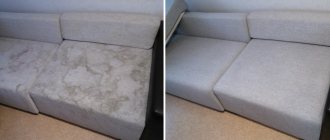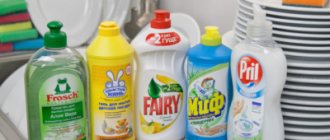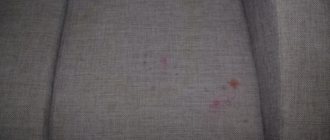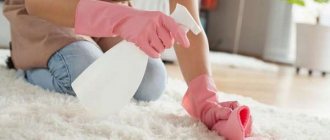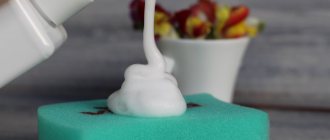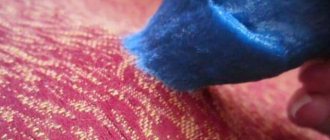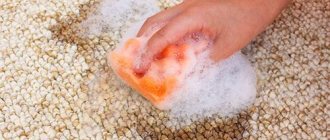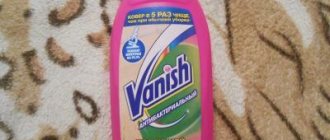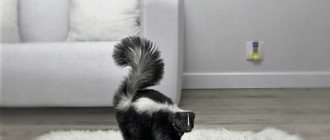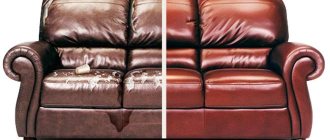Basic cleaning rules
Any cleaning that is expected to have a positive effect must occur in accordance with certain rules. This also applies to removing grease stains from the sofa, for which it is advisable to follow certain recommendations:
- before applying the selected product to the main upholstery, it must be tested on an inconspicuous area to avoid significant damage to the sofa;
- any stain is cleaned from its edges to the center and nothing else;
- when using caustic chemicals, for example, ammonia, the windows should be ventilated and a gauze bandage should be worn;
- If you haven’t carried out preventative cleaning of the sofa for a long time, you first need to get rid of the dirt, and then clean all the upholstery.
How to properly remove grease from a sofa?
When talking about how to remove a greasy stain from a sofa upholstery, you need to remember talc and corn starch, which are excellent at removing fresh stains . They absorb the type of contaminants in question better than regular baking soda or salt. They are used like this:
- if the stain is fresh, use paper towels to absorb the oil;
- Apply cornstarch or talcum powder to the stain;
- After 10-15 minutes, remove the organic powder using a dry cloth.
If you need to clean your sofa from old greasy stains, then use the “heavy artillery” - dishwashing detergent . Be sure to first cover the trace with an absorbent (starch, talc, salt, baby powder, etc.), leaving it for a quarter of an hour. After that, proceed like this:
- Apply a drop of detergent to the stain, gently rubbing it from the edges of the stain to the center ;
- rub the area with a sponge or cloth soaked in warm water;
- wait 25 minutes. Rinse off the product with a damp sponge;
- Dry the cleaned area and repeat the procedure if necessary.
This method will be a good assistant in the question of how to remove an oil stain from a sofa, but after using water and detergent, stains may remain on the upholstery. If you need to remove a greasy stain from a sofa without streaks, then it is advisable to use a household stain remover in the form of a spray or shampoo .
How to remove a grease stain from a sofa
There are two ways to get rid of a greasy stain from a sofa:
- using available means;
- using household chemicals.
Depending on the size and age of the grease stain, both methods are quite effective, but some of them are not suitable for all types of materials. Therefore, when cleaning dirt, first of all, determine what material your upholstery is made of, and only then start cleaning.
Pile upholstery: chenille, velor, flock
Fresh stains on pile fabrics are removed in several ways:
- Sprinkle salt over the entire surface of the stain (you can use flavored sea salt) and leave for 30 minutes. It is able to absorb fat and leave no trace. Once the salt has taken effect, remove it with a vacuum cleaner or brush.
- Add 30 ml of lemon juice and 15 ml of ammonia to 1 liter of warm water. Use a cotton pad soaked in the solution to treat the stain. Next, take a small piece of cotton and wet it in the same way, then spread it over the entire contaminated area. After 1.5 hours, wipe with a soap solution based on laundry soap, rinse with clean water and dry.
Natural fabrics: cotton, jacquard, tapestry, matting
Natural materials are more demanding. They do not “like” intense friction, aggressive chemicals and prolonged exposure to water. To remove a greasy stain from a sofa made of natural materials, you must follow these steps:
- Apply one of the following products to a fresh greasy stain: soda, starch, chalk. Leave it like this for 10-15 minutes, then remove the powder with a vacuum cleaner with a soft attachment.
- One of the weirdest ways is to use shaving foam. Apply it to the stain and gently rub it with a brush. After 7-10 minutes, remove the foam with a paper towel, wipe the area with a clean damp sponge and dry the upholstery.
Upholstery made of leatherette, leather, vinyl
Removing a greasy stain from a sofa made of such smooth materials as leatherette, leather, vinyl is, in principle, the easiest task, but it also requires the most careful approach:
- Beat the egg white until a stable foam forms and apply the entire mixture to the stain. After 7-10 minutes, remove the product with a paper or damp cloth and rinse with clean water.
- Add 30 ml of lemon juice or vinegar to 1 liter of warm water. Rinse the entire problem area first with the resulting solution, and then with clean water. The upholstery should not be left wet, so the final step is to wipe the surface dry with a soft cloth (cotton or microfiber).
Remove, remove at home from upholstered furniture
If a stain appears on the upholstery, it is better not to delay cleaning.
The faster the causes of pollution are removed, the less will be the consequences of this nuisance. To blot the stain, you need to arm yourself with paper napkins or towels, changing them until there are no traces left on the paper. Important! Under no circumstances should you rub the stains, otherwise the dirt will penetrate deeper. Before using the product, you should test its effect on an inconspicuous area to avoid possible deformation or discoloration of the upholstery.
Wipe off fat from oil
If an oil stain appears on the sofa, you can remove it using household products:
- Salt. Apply a thick layer to the greasy mark and leave for several hours to allow the dirt to soak into the salt. Residues are removed with a brush and vacuum cleaner. Salt can be replaced with any adsorbent (starch, chalk, baking soda, etc.);
- Dishwashing liquid. A thick layer of product applied to an oil or grease stain should be gently rubbed with a sponge. After 15 minutes, the upholstery should be washed and dried;
- Universal lubricant WD-40. Apply to old and dried oil stains and after a couple of minutes, gently blot with a clean cloth. Then fill this place with any powdered adsorbent (salt, soda, chalk, etc.) and leave for several hours. After this, all that remains is to vacuum and dry the upholstered furniture. Lighter fluid can replace WD-40. After use, the upholstery should be rinsed thoroughly with water;
- Shaving cream (foam). Apply to the stained area and rub in with an old toothbrush. Then use a dry cloth to remove the cream, and wipe the treated area with a damp cloth;
- Turpentine. It must be preheated in a container with hot water, lowering the bottle there for 5 minutes, and then apply thickly to the upholstery of upholstered furniture. After two hours, cover the treated area with soda and clean thoroughly with a brush. After this, you need to carefully rinse the upholstery with water and dry;
- A mixture of lemon juice and vinegar. Contaminated areas of upholstery that are generously moistened with the mixture (1 part each of juice and vinegar) should be rubbed with a brush, and the remaining cleaner should be removed with soap and water.
Information. These tips are universal and suitable for most types of upholstered furniture. However, for delicate upholstery it is better to use special recipes:
- Velvet is cleaned of greasy stains with white bread crumbs, which must be rolled over the contaminated area;
- You can remove greasy marks from suede using salt and alcohol by covering the stain with salt for a few minutes. After removing the residue with a vacuum cleaner, you need to wipe the contaminated area with a cotton pad soaked in alcohol;
- For upholstery made of genuine leather, laundry soap based on bile or a beaten egg is suitable;
- Shaving foam will save velor from greasy marks. Having smeared the stains with the product, you need to rub them in a circular motion, gradually moving from the edges to the center. After a few minutes, the remaining product is washed off with warm water;
- It is unacceptable to use preparations with bleaching components for dark fabric upholstery. A suitable remedy with a gentle effect is ordinary dry mustard, from which you need to prepare a paste and lubricate fresh greasy marks. When the mustard dries, all that remains is to wash it off with water and dry the upholstery.
This is interesting: How to remove stains from fabrics: cotton, wool, silk, synthetics
From plasticine from upholstery
Children simply love plasticine. However, parents are not at all happy with the consequences of such creative games if the remains of the modeling material end up on the upholstered furniture. The following tips will help you deal with plasticine stains:
- The contaminated area of the upholstery is generously moistened with a solution of laundry soap and water. After half an hour, rub the stain with a brush and rinse with clean water. If after washing it was not possible to get rid of the plasticine, you should pour a little soda on this area and rub it with a brush again. This method is suitable for light-colored fabrics, since whitish stains may remain on colored upholstery after processing;
- Using a cotton swab soaked in a solution of 1 glass of water and 10 drops of ammonia, you need to rub the plasticine stain until its remnants are completely removed. After this, the upholstery should be rinsed with water and dried;
- Vegetable oil, generously applied to the area of upholstery stained with plasticine, must be thoroughly rubbed over the stain with a clean napkin. After cleaning, the upholstery is treated with any grease remover (for example, dishwashing detergent) and thoroughly washed with clean water;
- You can cover the stain with ice cubes or a frozen chicken carcass and leave it for a while. Cooled plasticine becomes harder and is easily removed from the upholstery;
- Ironing the stain through a sheet of clean white paper will help remove plasticine marks. The melted plasticine will remain on the paper. You can replace the iron with a hairdryer. The remaining grease stain can be removed using the tips in this article;
- If marks on upholstered furniture appeared after using the so-called “smart plasticine”, then they can be removed at home only from upholstery made of natural fabrics (cotton, linen, wool, etc.).
The wax included in the modeling material is wiped off using cleaning alcohol - 70% isopropyl alcohol. After moistening the stain with it, you need to wait a few minutes until the “smart plasticine” dissolves, and blot the remaining product with a dry cloth and rinse with water.
From the iron
Dropping the iron on the sofa while ironing or clumsiness when removing plasticine residues on the upholstery can lead to the appearance of characteristic stains. Tips from housewives will help you cope with them. It must be remembered that these methods are only relevant for small traces of thermal effects:
- Use a cloth soaked in hydrogen peroxide with a few drops of ammonia to rub the stain and then rinse with water. Any composition with an acidic environment, for example, vinegar or whey, will also help;
- The iron stain can be rubbed with a fresh cut of the onion. The remains of the onion are washed off with a sponge soaked in clean water;
- For white upholstery, a solution based on regular white is suitable;
- The lemon, grated on a coarse grater, should be spread on the scorched area of the upholstery and left for 20 minutes. After which the upholstered furniture is wiped with clean water;
- Barely noticeable iron marks can be wiped off using a regular office eraser.
Attention! If the iron burns a deep hole or severely scorches the upholstery, it is better to contact a repair shop.
Get rid of coffee, tea
Traces of hot drinks can haunt those who drink a cup of tea or coffee while sitting on a soft sofa while watching the morning news or a long-awaited TV series.
The following tips will help you deal with them (stains, not tea and coffee lovers):
- A solution of 1 tbsp. l. glycerin and 1 l. Apply plenty of water to the upholstery using a sponge, which must be used to rub the contaminated area. Then the remaining product should be washed off with clean water and the upholstered furniture should be dried. Repeat the procedure if necessary;
- A 10% borax solution will help clean colored upholstery of upholstered furniture. A paste of citric acid, baking soda and water will remove any remaining borax. After this, the upholstery should be rinsed first with cold and then with warm water;
- Fresh marks are cleaned with dishwashing detergent or liquid soap;
- For old stains, use a white cloth soaked in warm water to moisten the stain, and then apply a solution of equal parts water and vinegar to it. After 10 minutes, the residue is removed with a dry cloth, and the upholstery is washed with warm water;
- Leave paper towels soaked in isopropyl or regular alcohol on the stain for a couple of minutes, and then rub the area with them until the stain disappears. Residues of alcohol are removed with plain water.
Chemicals
In order not to experiment with traditional methods, many people prefer the usual professional products, which can be bought at any household chemicals store. Typically, such products contain substances that can break down fat from inside the fibers. All funds can be divided into two areas:
- universal;
- highly specialized.
The former can be used on any upholstery material, and in some cases even on other interior items: curtains, carpets, bedspreads, blinds, etc. In addition, they will remove not only greasy stains from the sofa, but also traces of berries, fruits, coffee or tea stains, as well as felt-tip pens, ballpoint pens, etc. But the latter are designed exclusively for a specific type of fabric. For example, it can be silk, cotton, jacquard, wool, and they are intended for only one or two types of pollution, no more.
All household chemicals that will help you remove grease stains from the sofa have their own presentation:
- gel;
- shampoo;
- spray;
- active foam;
- soap;
- powder.
As a rule, removing a greasy stain from a sofa is not difficult, especially if the stain is fresh and you noticed the problem in time. If you doubt that you will be able to do this without harming the furniture, it is better to contact a professional dry cleaner.
How to remove a fresh grease stain from a sofa upholstery
The difference between fresh stains of any origin is that they are much easier to remove than dried ones and, especially, old ones. What to do if you put a stain on upholstered furniture? Put everything aside and clean it right away. Better yet, leave a request. We will arrive at a time convenient for you. What you need to do to minimize damage from grease stains on upholstery:
- blot it with paper napkins, towels or toilet paper - whatever you have on hand. Collect as much fat as possible so that almost none remains on the textile or leather upholstery;
- Sprinkle the stain with salt or baking soda. Both substances are excellent absorbents. They will absorb the fat inside the crystals, and only a small part of it will remain on the fabric. You will get a similar result using talc, chalk, potato starch;
- use stain remover spray or Vanish active foam. The stain remover is convenient for spot application on grease-stained surfaces. It is more advisable to use active foam to remove large oil stains. Before use, read the information on the packaging. Follow it without violating the recommendations of the manufacturer of household chemicals.
IMPORTANT : before cleaning, despite the desire to remove fat as quickly as possible, read the furniture manufacturer's instructions on the back wall of the sofa. You will know exactly what upholstery cleaning methods are acceptable and what not.
How to remove grease from fabric upholstery on a sofa
Once the absorbent is removed, the grease stain may disappear completely. Then all that remains is to wipe the area where it was with a well-wrung out cloth to completely remove traces of the absorbent. It happens that not all the fat can be collected. Then prepare a dense foam from Fairy solution or other dishwashing detergent. Their formulas contain components that break down fat. They are suitable for removing grease stains from textile upholstery of a sofa. The main condition is to use foam, not solution. This will protect the upholstery and filling of the sofa from getting wet, damp, mold, and musty smell.
